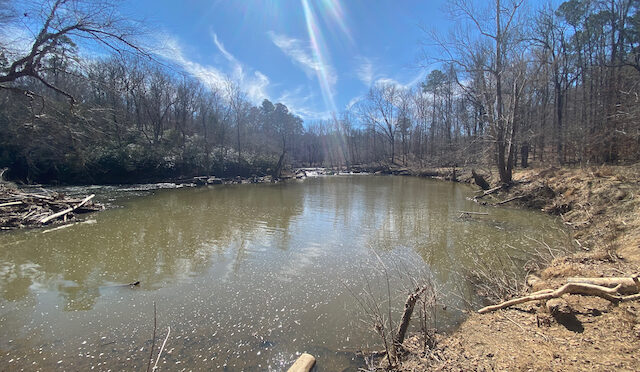We’re all about Spring this week, with the first sightings of trout lilies and spring beauties, and 70-degree weather in the wings. This should be the week that spring bursts out in all its eagerly awaited glory.
That said, today we crib from our GetHiking! Spring Wildflowers tip sheet and share some insights into where to look for spring and what it is you’re looking for.
First responders
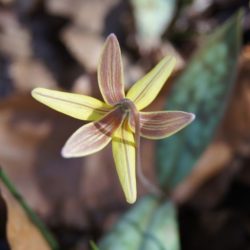
In the Piedmont, the trout lily and spring beauty are among the first prominent wildflowers to reveal themselves.
We typically start looking both after the first warm, sunny day of February. Warmth and sunlight kickstart the process, a process that may be slowed by February’s subsequent
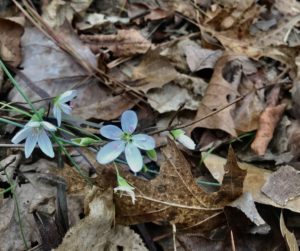
cold, but a process worth catching in its initial phases.
Shortly after the trout lily and spring beauties we typically see periwinkle and chickweed, then a burst of flowers that can be difficult to tell apart.
Where to look
Wildflowers can be hard to find. Some thoughts on where to look:
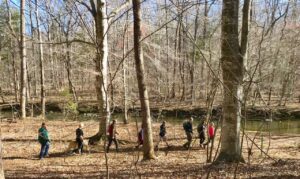
Deciduous woods. A good place to find the earliest spring wildflowers is in a deciduous forest. Wildflowers bloom early so they can soak up the sun and do their life-sustaining business before the hardwoods leaf out and blot out the sun. Typically, you won’t find them in woods dominated by pines, for the very reason that evergreens maintain a full canopy year round, frustrating the efforts of wildflowers to find the sunlight they need.
Bottomland forest. Especially fruitful for some spring wildflowers are flat bottomland forests of deciduous trees. The soil is typically fertile and the bottomlands more mature woods more spaced apart, allowing more pre-canopy sunshine to filter in.
Park or forest website .Often, if you go on the website for where you plan to hike, they will mention when and where you can find wildflower blooms, and what to look for. Spring wildflowers may not have quite the cache of fall color, but parks do recognize their strong draw and will do their best to help you out. Another option is to call the visitor center or park office. I’ve found some of the most knowledgable people in a park or forest to be the ones on the front lines — at the reception desk.
IDing your wildflowers
It’s pretty, but what is it? Some good ways to identify your find.
A Virtual Wildflower Garden Across Time, part of the Field and Swamp website. We like this site for several reasons. One, it’s local, originating out of Durham, N.C.. Two, it lets you identify wildflowers in two critical ways. First, by color: white, yellow, orange/yellow-orange, red, pink or purplish pink, purple or blue, green, brown dn black. But then, and this is the part we really like, by time of bloom. The site has photos of each plant from around the region, along with when and where the photo was taken. And the arrangement isn’t by name, but rather by the flower’s seasonal debut into the world. It can be a little disorienting: chickweed appears in January, spring beauties afterward (we almost always see them in reverse order). But such arranging helps you keep from mistaking a spring beauty from the later blooming field pansy. Find this guide here.
Other options:
-
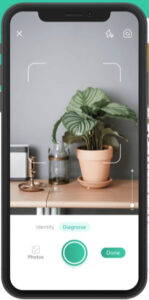
Picture This Apps. wildflowermd.com sites seven apps is likes in this post. Most employ some technology, but follow a format similar to traditional print guides, requiring you pursue a line of taxonomy to narrow down your options and identify your flower. Our favorite is Picture This. Simply take a picture and the app uses artificial intelligence to match it up with more than 10,000 plants in its database. The app claims a 99 percent accuracy rate. We’ve been using it a couple years know and find that percentage to be pretty accurate. It also lets you create your own “garden” of saved photos for future reference, or if you’re into keeping track of sightings. The only drawback: you need a signal for it to work (though if you don’t, you can save the plant’s photo and ID it when you do have a signal).
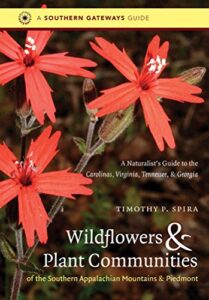 Guidebooks. Traditionally, we would tote a thick guidebook into the woods and attempt to make an ID based primarily on color, then on visual conformation. It’s quite a skill to pull off such a feat, especially with white wildflowers, which are prolific and exhibit have subtle differences. Apps such as Picture This make field ID much simpler. But if you prefer the challenge of using a guidebook, use one that’s specific to your area. In our case, we suggest “Wildflowers and Plant Communities of the Southern Appalachians and Piedmont: A Naturalist’s Guide to the Carolinas, Virginia, Tennessee, and Georgia.” A head’s up: it’s 539 pages. Find it here.
Guidebooks. Traditionally, we would tote a thick guidebook into the woods and attempt to make an ID based primarily on color, then on visual conformation. It’s quite a skill to pull off such a feat, especially with white wildflowers, which are prolific and exhibit have subtle differences. Apps such as Picture This make field ID much simpler. But if you prefer the challenge of using a guidebook, use one that’s specific to your area. In our case, we suggest “Wildflowers and Plant Communities of the Southern Appalachians and Piedmont: A Naturalist’s Guide to the Carolinas, Virginia, Tennessee, and Georgia.” A head’s up: it’s 539 pages. Find it here.- Guided hikes. Guided wildflower hikes abound this time of year. Most state parks have ranger-led hikes, as do some county and municipal parks. Nature conservancies, land trusts and other preserves make use of the showy spring displays to showcase their work. Most such hikes are free.
* * *
Spend spring with us
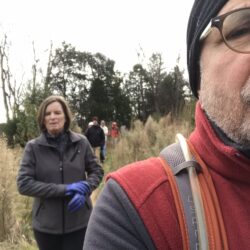 We’ve got a variety of hiking programs planned for spring, including 10-week series for Sunday morning and Sunday afternoon, a 10-week Tuesday Evening hike series and a Wednesday evening program for beginning hikers. Got a group or business team you’d like to get hiking? We can help you with that, too. Learn about our spring lineup here.
We’ve got a variety of hiking programs planned for spring, including 10-week series for Sunday morning and Sunday afternoon, a 10-week Tuesday Evening hike series and a Wednesday evening program for beginning hikers. Got a group or business team you’d like to get hiking? We can help you with that, too. Learn about our spring lineup here.
